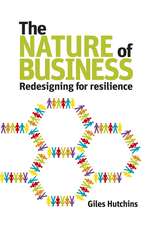Theory and Practices on Innovating for Sustainable Development
Autor Yoram Krozeren Limba Engleză Paperback – 23 aug 2016
| Toate formatele și edițiile | Preț | Express |
|---|---|---|
| Paperback (1) | 383.12 lei 6-8 săpt. | |
| Springer International Publishing – 23 aug 2016 | 383.12 lei 6-8 săpt. | |
| Hardback (1) | 398.74 lei 3-5 săpt. | |
| Springer International Publishing – 11 sep 2015 | 398.74 lei 3-5 săpt. |
Preț: 383.12 lei
Nou
Puncte Express: 575
Preț estimativ în valută:
73.31€ • 78.39$ • 61.12£
73.31€ • 78.39$ • 61.12£
Carte tipărită la comandă
Livrare economică 17 aprilie-01 mai
Preluare comenzi: 021 569.72.76
Specificații
ISBN-13: 9783319350325
ISBN-10: 3319350323
Pagini: 195
Ilustrații: XI, 195 p.
Dimensiuni: 155 x 235 mm
Greutate: 0.3 kg
Ediția:Softcover reprint of the original 1st ed. 2016
Editura: Springer International Publishing
Colecția Springer
Locul publicării:Cham, Switzerland
ISBN-10: 3319350323
Pagini: 195
Ilustrații: XI, 195 p.
Dimensiuni: 155 x 235 mm
Greutate: 0.3 kg
Ediția:Softcover reprint of the original 1st ed. 2016
Editura: Springer International Publishing
Colecția Springer
Locul publicării:Cham, Switzerland
Cuprins
Introduction.- Income Growth and Environmental Impacts.- Markets of Sustainable Innovations.- User Innovations in Solar Power.- Tacit Inventors in Regions.- Arts for Environmental Qualities.- Technology Suppliers for Sanitation.- Alternatives for Commuting.- Ethical Consumers and Producers.- Sustainable Investors and Innovators.- Energy Services for Smart Grid.- Renewable Energy Business and Policy.- Conclusions on Sustainable Innovations.- Index.
Textul de pe ultima copertă
This book explains how income growth and better environmental qualities go hand in hand, and reviews the drivers and barriers to sustainable innovation on the basis of real-life cases. It discusses why innovation-based income growth reduces environmental impacts and how the huge global markets for sustainable innovation are currently hampered by protectionist policies. Subsequently, diverse sustainable innovators are presented in ascending order of the complexity of interactions between innovators and stakeholders. In this context, innovating consumers who create communities of peers in solar powered mobility are examined in the first case. It also focuses on regional tacit inventors, who spur innovation in tourism mobility thanks to the informal policies but whose efforts are obstructed by the formalities of the European Union. Artists with an interest in both innovations and the environment develop art services that deliver experiences of environmental qualities. Though these experiences have gone unrecognised so far, they are nonetheless socially beneficial. The book also shows how technology suppliers develop four different patterns of sanitation, each with its own pros and cons for the specific community’s needs and conditions. It discusses how project developers also make innovations in office systems, including socially beneficial ones that do away with the need to commute. It includes an analysis of interactions between consumers pursuing ethical consumption and international trailblazers in corporate responsibility and concludes that it is more rewarding to support social entrepreneurs than to attempt to moralise consumers. Further analysis of interactions between sustainable investors and innovators reveals different groups’ opinions about policies and markets, helping to explains their weak influence on policies. Mushrooming local energy initiatives are now evolving into energy service companies, producing shifts on energy markets. Why theseinnovators emerge and how certain policies are blocking them are explained. The policies of the United States and European Union are compared with regard to the main barriers to, and drivers of, the renewable energy business. Though the US invests more money and takes more risks, it is less cost-effective in terms of the number of enterprises and jobs, thanks to the feed-in tariffs in Europe. Lastly, the book also discusses policies that invest in education, skills, knowledge and know-how exchange, but instead abolish perverse subventions of vested interests to create conditions for sustainable development.
Caracteristici
The first book to offer a thorough review of sustainable innovations Explores the diversity of innovators for sustainable development Underpins how environmentalist actions evolve into multi-billion markets















